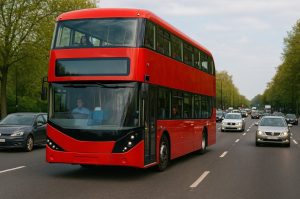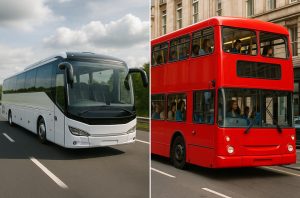Why is it that every car journey requires passengers to buckle up, yet when stepping onto a public bus, people are free to sit or even stand, without a seatbelt? For many, this seems inconsistent or even unsafe. In fact, the question “why don’t buses have seatbelts?” is one of the most common concerns raised about public transport safety.
The reality is that buses are built very differently from smaller vehicles, and their safety does not rely on seatbelts in the same way. Understanding why involves looking at engineering design, practical challenges, legal requirements, and accident data.
What Makes Buses Safer Than Cars Without Seatbelts?

One of the main reasons buses do not need seatbelts is that they are inherently safer due to their size and weight. A standard double-decker bus weighs several tonnes, far more than the average car. This sheer mass provides stability and makes buses less likely to be thrown off course in collisions.
The heavier build also means that buses are rarely involved in high-speed, high-impact crashes. Most operate in urban environments with frequent stops, traffic lights, and low speed limits. Even when accidents occur, the reduced speed typically lowers the risk of life-threatening injuries compared with motorway collisions involving cars.
In addition, buses are constructed on strong frames, often similar to lorries, designed to absorb and distribute the force of an impact. This makes them more resistant to serious structural damage in accidents, further protecting passengers.
How Does Compartmentalisation Protect Passengers?
The term compartmentalisation describes the way buses use their seating layout to protect passengers. Instead of relying on seatbelts to restrain individuals, the design of the seats themselves forms a safety system.
Seats in buses are placed close together, are tall, and are heavily padded. In the event of a sudden stop or collision, passengers are contained within a small “compartment” that prevents them from being thrown forward with great force. The energy of the impact is absorbed by the padded seats in front, limiting injury.
This approach has been tested extensively, especially in the United States with school buses, and has been shown to provide strong protection in low- to medium-speed crashes. For the kind of travel buses are designed for, compartmentalisation offers safety benefits comparable to what seatbelts would provide.
Why Would Seatbelts Be Impractical on Buses?

The idea of adding seatbelts to buses may sound straightforward, but in practice it creates serious challenges. One of the most obvious issues is that many bus services allow standing passengers.
For busy city routes, this flexibility is essential to carry enough people during rush hours. If seatbelts were required, standing would no longer be possible, reducing capacity and making urban transport less efficient.
Frequent stops also add to the difficulty. Passengers are constantly boarding and leaving. Expecting every passenger to buckle and unbuckle a belt every few minutes would delay services and create unnecessary congestion.
Another consideration is enforcement. In cars, drivers can easily ensure that all passengers are wearing seatbelts before moving off. On buses carrying dozens of people, it would be impossible for drivers to monitor every passenger while focusing on safe driving. This makes compulsory seatbelt use impractical.
Is the Cost of Installing Seatbelts a Factor?
Cost also plays a role in why buses do not generally have seatbelts. Retrofitting seatbelts into existing fleets or designing new buses with reinforced structures to support belts would require a significant financial investment. This includes not just the belts themselves but also the modifications needed to anchor them securely.
Maintenance would be another long-term expense. Seatbelts require regular checks and replacements when damaged, which would place ongoing costs on operators.
Given that buses already demonstrate excellent safety records without belts, regulators have concluded that the money would be better spent on other improvements such as driver training, vehicle technology, or expanding services.
What Do Safety Statistics Reveal About Buses Without Seatbelts?
Statistics provide clear evidence that buses are among the safest ways to travel on the road. Government data consistently shows far lower casualty rates for bus and coach passengers compared with other road users.
| Mode of Transport | Casualties per Billion Passenger Kilometres (UK) |
| Car occupants | ~25 |
| Pedestrians | ~35 |
| Cyclists | ~100 |
| Bus/coach passengers | ~3 |
These figures demonstrate that buses remain significantly safer than cars, bicycles, or walking. The combination of their mass, professional drivers, and compartmentalised design helps to explain why accident survival rates are so high without the use of seatbelts.
Why Do Coaches Have Seatbelts But Buses Do Not?

The distinction between buses and coaches is key. Coaches are used for long-distance journeys, often at higher speeds on motorways. At these speeds, the energy involved in a collision is much greater, making seatbelts necessary to protect passengers.
Buses, on the other hand, are designed for short journeys within towns and cities, where speeds are lower and the chances of severe crashes are reduced. They are also designed to accommodate standing passengers, which makes the use of seatbelts impractical.
School transport highlights this difference well. In the UK, when children are transported by coaches, seatbelts are required by law. However, when standard service buses are used, the same rules do not apply.
Internationally, approaches vary. In the United States, for example, some states require school buses to have seatbelts, while others rely on compartmentalisation as the primary safety measure.
Could Seatbelts Make Buses Safer in Accidents?
The debate about whether seatbelts could make buses safer continues. Supporters argue that in rare but severe crashes, especially rollovers, seatbelts could reduce injuries. Critics point out that these types of accidents are extremely uncommon in urban bus travel.
There are also situations where seatbelts might actually increase risk. In emergencies such as a fire or overturned vehicle, passengers need to leave quickly. Having to unfasten a belt could slow evacuations and increase danger.
On balance, most experts agree that the marginal benefits of belts on standard buses do not outweigh the complications they create.
Will Buses Ever Be Required to Have Seatbelts in the Future?
It is possible that regulations may change in the future, but current evidence suggests it is unlikely for local bus services. Instead, advances in technology are expected to play a greater role in improving passenger safety.
Modern buses are increasingly being fitted with features such as:
- Automatic emergency braking systems.
- Lane departure warnings.
- Collision detection technology.
These systems reduce the likelihood of accidents occurring in the first place, which is considered a more effective strategy than retrofitting buses with seatbelts.
Final Words
The question of why buses don’t have seatbelts can be answered by looking at how buses are built and used. Their large size and heavy weight reduce the risks of serious collisions.
The design of compartmentalised seating provides protection without the need for belts. Practical issues such as standing passengers, frequent stops, and enforcement make belts unworkable, while cost considerations further reduce the case for fitting them.
Coaches and certain school buses require seatbelts because they operate under different conditions, but standard buses remain one of the safest forms of transport without them. The absence of seatbelts is therefore not a weakness but a reflection of engineering design and decades of evidence supporting passenger safety.
FAQs
Are UK bus drivers required to wear seatbelts?
Yes. Drivers must wear a seatbelt if one is fitted, although there are exemptions for reversing or certain manoeuvres.
Do double-decker buses require seatbelts for passengers?
No. Double-deckers are exempt under UK law as they are designed for local journeys with standing passengers.
Why do coaches always have seatbelts?
Coaches travel at high speeds on motorways where crash forces are greater, so seatbelts are legally required.
What is meant by compartmentalisation in buses?
It refers to the seating design where padded, closely spaced seats form protective compartments that absorb crash energy and protect passengers.
Would seatbelts make buses safer in rollovers?
In rare high-speed rollovers, seatbelts may help. However, these accidents are extremely uncommon in urban bus travel.
Why is it impractical to enforce seatbelt use on buses?
With frequent stops and standing passengers, it would be impossible for drivers to ensure that everyone is properly wearing a seatbelt.
Do school buses in the UK require seatbelts?
If the vehicle is a coach, yes, belts must be worn. If it is a standard local bus, belts are not legally required.






